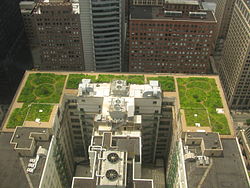Chicago City Hall
 Wikipedia defines a green roof as:
Wikipedia defines a green roof as:"A green roof is a roof of a building that is partially or completely covered with vegetation and soil, or a growing medium, planted over a waterproofing membrane. This does not refer to roofs which are merely colored green, as with green roof shingles. It may also include additional layers such as a root barrier and drainage and irrigation systems. Container gardens on roofs, where plants are maintained in pots, are not generally considered to be true green roofs, although this is an area of debate. Rooftop ponds are another form of green roofs which are used to treat greywater. The term green roof may also be used to indicate roofs that use some form of "green" technology, such as solar panels or a photovoltaic module. Green roofs are also referred to as eco-roofs, vegetated roofs, living roofs, and greenroofs."
Green roofs are used to:
* Grow fruits, vegetables, and flowers
* Reduce heating (by adding mass and thermal resistance value) and cooling (by evaporative cooling) loads on a building — especially if it is glassed in so as to act as a terrarium and passive solar heat reservoir — a concentration of green roofs in an urban area can even reduce the city's average temperatures during the summer
* Increase roof life span
* Reduce stormwater run off — see water-wise gardening
* Filter pollutants and carbon dioxide out of the air — see living wall
* The soil and plants on green roofs help to insulate a building for sound; the soil helps to block lower frequencies and the plants block higher frequencies.[2]
* Filter pollutants and heavy metals out of rainwater
* Increase wildlife habitat in built-up areas — see urban wilderness
A green roof is often a key component of an autonomous building.
A 2005 study by Brad Bass of the University of Toronto showed that green roofs can also reduce heat loss and energy consumption in winter conditions.[3]
In a recent study on the impacts of green infrastructure and in particular green roofs in the Greater Manchester area, researchers found that adding green roofs will help keep temperatures down, particularly in urban areas: “adding green roofs to all buildings can have a dramatic effect on maximum surface temperatures, keeping temperatures below the 1961-1990 current form case for all time periods and emissions scenarios. Roof greening makes the biggest difference…where the building proportion is high and the evaporative fraction is low. Thus, the largest difference was made in the town centers.” [4]

I think the really interesting thing is that living roofs are not a new idea. When people began to first build structures to live in they used living materials to build with or build around. It first started to be conceptualized in an urban setting in the 60's when a forward-thinking group of college kids set up a completely independent urban house. Again we come back to the idea that to be truly independent we must be dependent, the question is just on what? Can we be dependent on our own homes to help us sustain and enrich our lives and the environment in which we live or will we succumb to the masses and live solely for ourselves as parasites on our beautifully tragic earth? The answer is that it is possible and there are amazing people out there making it happen and showing people how to accomplish it every day. Keep up the beautiful work.
ReplyDelete